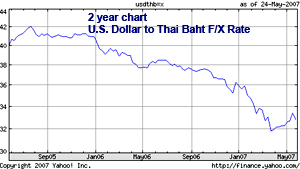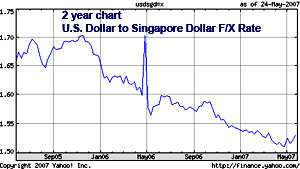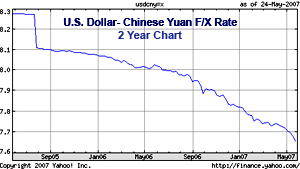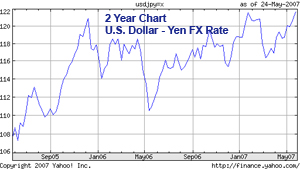May 26, 2007 – I’m sure a bigger part of the discussion about these “pooled Asian reserves” not publicly discussed revolves around China’s continuing plans to diversify out of their huge dollar denominated reserves. All participating countries in this reserve pool must wonder how this can be achieved without greatly harming the value of their respective dollar denominated reserve pools. In the end, the media always takes conferences on face value and never digs  deeper but I assure you that concerns about the dollar’s continuing fall was the top agenda for this meeting and not concern for another re-occurrence of a 1997 financial crisis. Firstly, since the introduction of the Euro as an alternative international currency and an important holding of all country’s reserves, speculative attacks on a nation’s currency are more difficult to manufacture. Furthermore, many countries no longer hold a dollar peg, as
deeper but I assure you that concerns about the dollar’s continuing fall was the top agenda for this meeting and not concern for another re-occurrence of a 1997 financial crisis. Firstly, since the introduction of the Euro as an alternative international currency and an important holding of all country’s reserves, speculative attacks on a nation’s currency are more difficult to manufacture. Furthermore, many countries no longer hold a dollar peg, as  was often the choice when the dollar was the only major international currency. Now many countries peg their domestic currency to a basket of international currencies, a move that will widely dampen any continuing weakness of the dollar.
was often the choice when the dollar was the only major international currency. Now many countries peg their domestic currency to a basket of international currencies, a move that will widely dampen any continuing weakness of the dollar.
Secondly, if we look at the exchange rate graphs of all the major Asian currencies, does it look like these countries should be worried about massive devaluations of their currencies against the U.S. dollar as they claim they are?
 The scale of these charts are not uniform so just looking at the graphs would lead to some incorrect conclusions. In order to inspect a more accurate picture let’s look at the percent appreciations. Singapore and China have respectively allowed their currencies to appreciate by about 10.3% and 7.8% over the past 2 years against the dollar, Korea a little over 11.8%, and Thailand, a ridiculous 21.5%. On the other hand Hong Kong has allowed its
The scale of these charts are not uniform so just looking at the graphs would lead to some incorrect conclusions. In order to inspect a more accurate picture let’s look at the percent appreciations. Singapore and China have respectively allowed their currencies to appreciate by about 10.3% and 7.8% over the past 2 years against the dollar, Korea a little over 11.8%, and Thailand, a ridiculous 21.5%. On the other hand Hong Kong has allowed its  currency to weaken very slightly, less than 0.6% over two years (graph not presented here), while Japan has allowed the dollar to strengthen about 11.5% against the yen during this same period. So the only uncharacteristic countries among this group in the past year has been the two outliers, Thailand and Japan.
currency to weaken very slightly, less than 0.6% over two years (graph not presented here), while Japan has allowed the dollar to strengthen about 11.5% against the yen during this same period. So the only uncharacteristic countries among this group in the past year has been the two outliers, Thailand and Japan.
The yen’s weakness against the dollar has been understandable as the Central Bank of Japan has aggressively adopted a “weak yen” policy for the past several years to assist Japanese exports and help Japan recover from an extended period of recession. In Thailand, it should be self-evident who is benefiting from their ultra-aggressive strong baht policy. Of course, all this dollar weakness would not be possible without the silent complicity of the U.S. Federal Reserve as well. A weak dollar contributes to U.S. trade deficits shrinking as well as erodes the value of debt the U.S. government must repay. However the most important players in this group by far are the two countries holding the greatest amount of dollar denominated reserves, Japan and China.
Though China’s currency has recently strengthened, this strength hasn’t been proportional to the explosive growth of the Chinese economy, and the U.S. Congress has accused China of keeping the yuan artificially weak against market conditions, even in spite of its nearly 8% rise against the dollar in the past two years. No doubt China holds all the cards in the Asean regional countries. Although many viewed China’s end of its decade long peg of the yuan to the U.S. dollar as caving to U.S. pressure, I don’t at all. It’s simply intelligent planning to end a peg to a currency that you plan to divest of. In fact, ending the peg makes it far less painful of a divestment process as other currencies held in the basket of currencies should strengthen and help offset losses incurred by remaining dollar denominated reserves. Japan holds the second largest pool of dollar denominated reserves and obviously has vastly different domestic currency policy objectives than China. Determining how to reconcile these different policy objectives I’m sure, was a huge part of the discussion about the Asian reserve currency pool.
Finally no doubt that these Asian countries also have been discussing what the Middle East is doing with their vast pool of petrodollar reserves (at least if they are smart they are) and how that is likely to affect their plans as well.
[tags]dollar crisis, 1997 Asian financial crisis, dollar versus Asian currencies[/tags]
__________________
J.S. Kim is the founder and Managing Director of maalamalama, a comprehensive online investment course that uses novel, proprietary advanced wealth planning techniques and the long tail of investing to identify low-risk, high-reward investment opportunities that seek to yield 25% or greater annual returns.